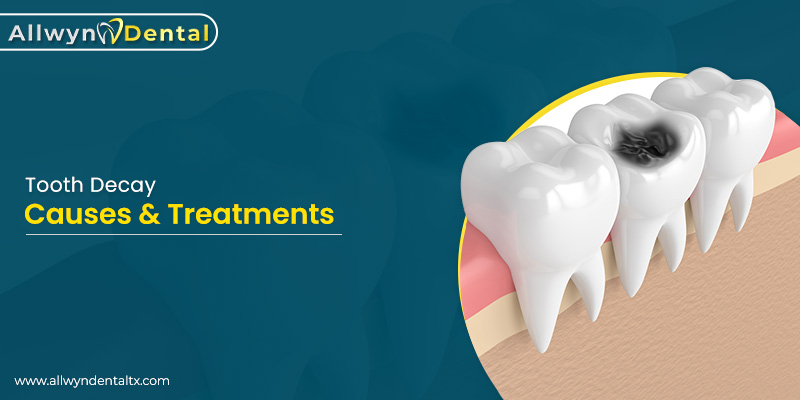What is Tooth Decay, and What are the Main Causes of Tooth Decay?

Allwyn Dental
March 30, 2023
ORAL HEALTH. Oral Health. oral health.
Do you notice something? Yes, it’s the way we wrote oral health. It signifies the amount of stress and importance we want to give to oral health each time we have written it. The last version is least stressed upon, and generally, that is the reality, as people often ignore oral issues like tooth decay, loss of teeth, or gum disease.
Now that the blog begins with so much stress on oral health let’s narrow it down to a common oral problem, i.e., tooth decay. Don’t worry; reading this is not one of the factors leading to tooth decay, but poor diet is. Let’s begin.
What is Tooth Decay?
Of course, it is an oral disease that leaves an impact on enamel which rhymes with caramel, but it is more than just a rhyming word. According to the American Dental Association (ADA), a tooth just like soil consists of three layers; let’s understand them briefly.
- Enamel: It is the external or outer layer of the tooth that protects the internal layers. Tooth Enamel, a hard oral layer is also known to be the most solid structure of the human body that does not host any living cell.
- Dentin: It is the tooth’s second layer responsible for sensitivity. After the enamel suffers from damage, the dentin consisting of small tubes is exposed. Those tubes allow cold and hot edibles to stimulate nerves in the tooth’s root or leg, responsible for the tooth’s sensitivity and pain.
- Pulp: The name is as easy as the function. It is the tooth structure’s center which consists of nerves, connective tissues, and blood vessels.
Coming back to tooth decay. It results from bacteria generating acid to attack the tooth enamel of your mouth. It can result in dental caries or tooth cavities, which hollow your teeth.
Even though the severity of tooth decay varies with the patient, if untreated or ignored, it can lead to an infection, damage all the layers of your tooth, and even end up losing your teeth.
What are the Signs of Tooth Decay?
The signs or symptoms of tooth decay vary with severity. They can play hide and seek with you when the decay starts and then properly appear or become noticeable as the condition intensifies. However, if you experience any sign of tooth decay, immediately consult your dentist at Allwyn Dental. Some of the symptoms that can help you self-analyze tooth decay are.
- Tooth becomes sensitive to hot, cold, or sugary food
- Cavities and bad breath
- The tooth hosts dark or white spots
- Consistent pain
- A loose filling
- A dental abscess or pus on teeth that leads to swollen face, pain, or fever
- Food traps in the teeth frequently
- Chewing or biting becomes difficult
What are the Main Causes of Tooth Decay?
Prevalent among every age group, dental caries, also known as tooth decay, is a combination of several factors damaging enamel and giving rise to tooth cavities. However, the story begins with a plaque.
Plaque signifies the prevalence of harmful bacteria in our mouths. It is a sticky substance resulting from consuming high sugar and not cleaning the teeth properly. It covers your teeth and turns into tartar by hardening either above or under your gums which ultimately makes it more difficult to remove plaque.
The acidic plaque affects minerals in the tooth enamel, which causes it to erode. Here you are at the first stage of the cavity with tiny holes in your enamel, the hardest layer. Now begins the destructive part when the plaque reaches dentin (the second layer of your tooth) and pulp (the center of your tooth).
The tiny tubes in dentin lead to sensitivity, finally causing the pulp to swell. The irritated and swollen pulp presses the nerves, which causes pain. In addition, even the roots and bones can feel discomfort. Let’s comprehend some of the common reasons behind plaque leading to tooth decay.
- Irregular or improper cleaning and brushing routines can lead to the accumulation of plaque, which creates acid to attack the tooth enamel of your tooth.
- Saliva neutralizes acidic content and washes away bacteria along with food particles from your mouth. An absence or lack of saliva leads to a dry mouth, increasing the risk of tooth decay.
- Genetics plays an important role here as well. People with genetically weak tooth enamel have a high risk of suffering from tooth decay.
- Certain gastroesophageal conditions like GERD, acid reflux, and medical eating disorders like bulimia and anorexia can cause tooth decay since they expose teeth to stomach or abdomen acids which can lead to the erosion of the tooth enamel.
- High consumption of foods and drinks rich in acid, sugar, and carbohydrates can increase the risk of tooth decay since plaque bacteria can quickly convert sugar and starch into acids, leading to enamel erosion.
How is Tooth Decay Diagnosed?
While you may be able to figure out certain symptoms or signs of tooth decay, you still need to visit dentists for in-depth examination, conclusion, and treatment. Your dentist may generally follow the steps mentioned below for accurate diagnosis.
- An External Examination: This includes understanding your medical history and scrutinizing your teeth for signs of damaged enamel, including pits, holes, or discoloration.
- Dental Instruments: using them, the dentist will examine sensitive or soft areas that reflect tooth decay.
- X-ray: Useful to thoroughly check areas or signs that are not visible to human eyes, such as decay or holes below the fillings or between teeth.
- Laser Detection: It helps quickly detect cavities or decay with the help of light or laser.
What are the Complications of Tooth Decay?
Tooth decay is a common oral problem. However, if left unattended, it can result in various complications such as loss of a tooth, infection, pain, and even abscesses. Abscesses are an accumulation of pus inside your gums or teeth. It is generally a result of bacterial infection in the pulp part of the tooth.
Bacterial infection is generally a result of plaque; thus, it is best not to ignore plaque and abscesses. Remember, the pus can further intensify complications by increasing the risk of fatal infections such as sepsis.
What are the Available Tooth Decay Treatments?
There are several options to treat tooth decay. Still, the dentist will recommend a suitable treatment only after analyzing the severity of the decay and the patient’s overall oral and physical health condition. Some of the common treatments to cure or improve tooth decay are.
Flouride Treatments
At the initial stages of the cavity, fluoride treatments can work wonders. It is a mineral that can increase enamel’s strength.
Dentists often suggest fluoride treatment to improve patients’ overall oral health while reducing the risk of tooth decay or tooth cavities. The mineral used in these treatments may be in the form of gel, solution, varnish, or foam. Even though fluoride is found in various dental care products like toothpaste and mouthwash, the treatment consists of a relatively higher dose to offer more significant and quicker benefits.
Dental Fillings
Dental fillings are another great way to treat tooth cavities or holes in teeth. The procedure involves removing the decayed tissue, which is then filled with a filling material. Finally, the dentist polishes the filling to ensure it fits and feels comfortable in the patient’s mouth.
Made from metals, glass, plastic, or any other material, a dental filling is famous for repairing and restoring the teeth’ structure. It is also helpful in case the tooth is worn out from grinding or nail-biting. Overall, dental fillings improve the tooth’s appearance and functionality while reducing the risk of further damage or decay. However, it is essential to periodically visit a dentist to ensure the durability and hygiene of your fillings.
Root Canal
It is a savior of your natural tooth. Yes, the root canal treats the infected roots of the teeth by eliminating the bacteria to save it from reinfection and further complication or damage. The elimination occurs by removing the inflamed pulp, cleaning, disinfecting, and finally, filling and sealing the tooth.
An experienced endodontist or dentist undertakes this dental procedure under local anesthesia, which results in a painless process. However, some patients can experience a certain level of discomfort after or during the treatment.
Tooth Extraction
Tooth Extraction dental procedure is generally done when severe oral damage is due to tooth decay or other oral problems. Pulling, or tooth extraction refers to removing a tooth from its socket. It is one of the last options when there is either no scope for repair/improvement or no space for the new tooth to erupt correctly.
Before extracting, the dentist will numb the area of extraction and surrounding tissues with the help of local anesthesia to reduce the possible discomfort. If necessary, your dentist may use available sedation options to keep you comfortable while extracting teeth. After successfully removing the teeth/tooth, the surgeon will use gauze to manage to bleed. In addition, you may also receive post-tooth extraction instructions or aftercare tips for a quicker recovery.
Can Tooth Decay be Prevented?
Absolutely. It is possible to stop or prevent tooth decay by.
- Consult your dentist about the current oral condition and available fluoride additives
- Limit sugary snacks and drinks
- Use toothpaste with fluoride to brush two times a day
- Intake of healthy and nutritious food that strengthens your enamel
- Periodically visit the dentist for regular check-ups and cleaning
Wrapping up
Oral health is at stake with a constant rise in sedentary lifestyles, food intake, and choices. To ensure the safety of your teeth, it is advisable to visit leading dental clinics like ours, i.e., Allwyn Dental, and go through periodical check-ups to avoid oral issues like tooth cavities.


